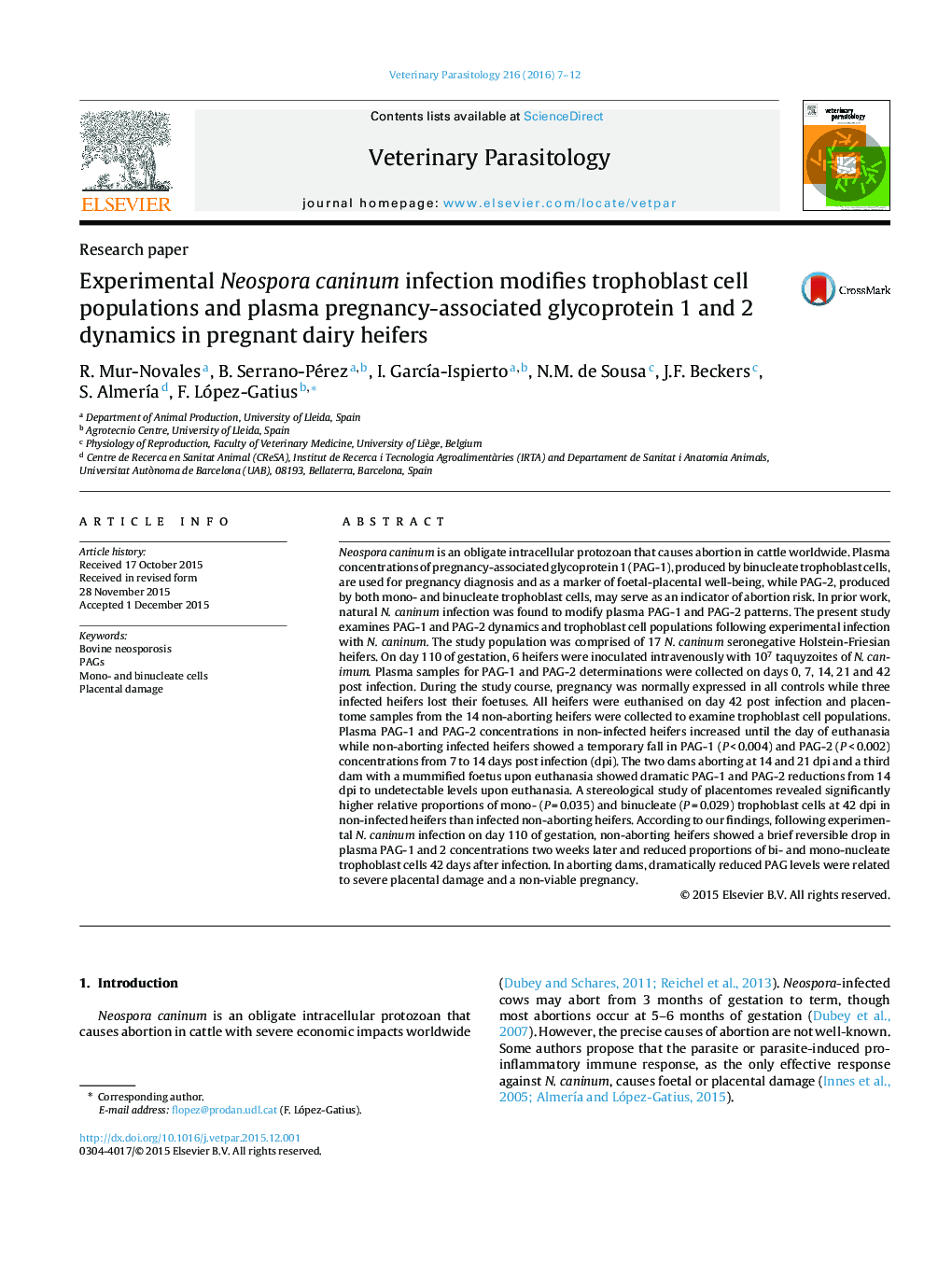| کد مقاله | کد نشریه | سال انتشار | مقاله انگلیسی | نسخه تمام متن |
|---|---|---|---|---|
| 2469952 | 1555660 | 2016 | 6 صفحه PDF | دانلود رایگان |

• Concentrations of pregnancy-associated glycoproteins 1 (PAG-1) and 2 (PAG-2) in response to experimental infection on day 110 of gestation with N. caninum in dairy heifers.
• Significant lower relative proportions of bi- and mono-nucleate trophoblast cells was detected in non-aborting Neospora-infected heifers 42 days post infection, compared to non-infected animals.
• Non-aborting Neospora-infected dairy heifers showed a brief transient reduction in PAG-1 and PAG-2 concentrations from 7 to 14 days post infection.
• Infected aborting dams showed a dramatic decline in PAGs until undetectable levels were recorded on day 42 post infection.
• Following infection with N. caninum, heifers suffer placental damage, though, in some animals, this damage will be overcome and pregnancy will successfully continue to term.
Neospora caninum is an obligate intracellular protozoan that causes abortion in cattle worldwide. Plasma concentrations of pregnancy-associated glycoprotein 1 (PAG-1), produced by binucleate trophoblast cells, are used for pregnancy diagnosis and as a marker of foetal-placental well-being, while PAG-2, produced by both mono- and binucleate trophoblast cells, may serve as an indicator of abortion risk. In prior work, natural N. caninum infection was found to modify plasma PAG-1 and PAG-2 patterns. The present study examines PAG-1 and PAG-2 dynamics and trophoblast cell populations following experimental infection with N. caninum. The study population was comprised of 17 N. caninum seronegative Holstein-Friesian heifers. On day 110 of gestation, 6 heifers were inoculated intravenously with 107 taquyzoites of N. canimum. Plasma samples for PAG-1 and PAG-2 determinations were collected on days 0, 7, 14, 21 and 42 post infection. During the study course, pregnancy was normally expressed in all controls while three infected heifers lost their foetuses. All heifers were euthanised on day 42 post infection and placentome samples from the 14 non-aborting heifers were collected to examine trophoblast cell populations. Plasma PAG-1 and PAG-2 concentrations in non-infected heifers increased until the day of euthanasia while non-aborting infected heifers showed a temporary fall in PAG-1 (P < 0.004) and PAG-2 (P < 0.002) concentrations from 7 to 14 days post infection (dpi). The two dams aborting at 14 and 21 dpi and a third dam with a mummified foetus upon euthanasia showed dramatic PAG-1 and PAG-2 reductions from 14 dpi to undetectable levels upon euthanasia. A stereological study of placentomes revealed significantly higher relative proportions of mono- (P = 0.035) and binucleate (P = 0.029) trophoblast cells at 42 dpi in non-infected heifers than infected non-aborting heifers. According to our findings, following experimental N. caninum infection on day 110 of gestation, non-aborting heifers showed a brief reversible drop in plasma PAG-1 and 2 concentrations two weeks later and reduced proportions of bi- and mono-nucleate trophoblast cells 42 days after infection. In aborting dams, dramatically reduced PAG levels were related to severe placental damage and a non-viable pregnancy.
Journal: Veterinary Parasitology - Volume 216, 30 January 2016, Pages 7–12